Guitar
In the early 70s, Fender switched from a traditional 4 screw or 4-bolt neck attachment to a 3-bolt attachment(actually 1 bolt and 2 screws) on the Stratocaster, the Jazz Bass and the Telecaster Bass. This new three-bolt attachment also incorporated a tilt adjustment, that could change the set angle of the neck in the body slightly.
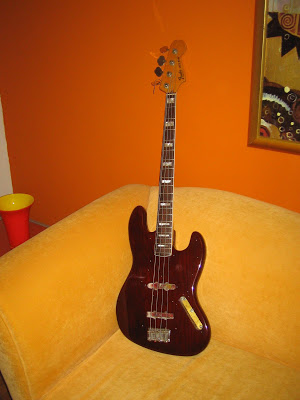
While the tilt adjustment must have seemed like a good idea to someone, the net result was a much less secure neck attachment which could result in the neck having substantial side-to-side play. As a result, many instruments from this era were converted to 4-bolt attachments, through plugging and redrilling of the attachment points and removal of the tilt adjustment apparatus.
Over the past year, I have worked on two different 3-bolt Jazz basses - one a 1977 very clean condition, and one a 1975 that had been stripped of its finish and most of its parts.
The 1977 Jazz was the first time I realized what the true problem with the 3-bolt attachment was: while playing the bass and literally, wringing it out - I kept hearing a little "click" - that sounded like it was coming from the base of the neck. I eventually realized I was hearing the neck shifting left and right in the neck pocket - certainly not a good thing!
The shift was big enough that by pushing the headstock all the way to the "treble" side, I was able to have the G-string be at almost the edge of the fretboard - so that it rolled off during playing!! Definitely not good!!
I also noticed that the very end of the neck pocket - where the neck butted up against - was not the smooth curve that matched the butt of the neck, but rather just touched the neck at the very centerline.
Since the 1977 Jazz had a perfect original finish and I was basically just prepping it for shipment to a friend overseas, I decided to take a kind of short cut approach to take the play out of the 3-bolt mount.
I doweled the holes in the body - and also glued some splinters of maple into the neck screw holes, just to tighten then up. Then I attached the neck with the single "bolt" - and aligned the neck using string between the nut and the bridge - clamping the neck in position using a clamp with soft rubber clamping surfaces.
I redrilled the holes in the body with a smaller diameter drill bit (sorry - I forget what size) - small enough such that the screws would have to be threaded through the body AND into the neck.
Then, while the neck was still clamped in position - I installed the two neck screws and tightened them down.
The results was that the shifting of the neck disappeared - even if the neck to body fit wasn't very good - because the play around the neck screws was gone. A simple fix that at least stabilized the bass.
Then, a few months later, I received another 3-bolt Jazz Bass - this time a stripped 1975. The owner wanted to convert to a 4-bolt attachment, but I convinced him to let me try to stabilize the neck with a more ambitious approach - rather than drilling a number of holes through the body and into the neck - which in my opinion would greatly reduce their "vintage" value down the road.
What I proposed was to shim the sides of the neck pocket and then to fill in and re-rout the area of the pocket that butts up against the neck - as well as tighten up the two screw holes through the body.
This combined approach would then result in the neck making more contact with the body plus it would tighten up the whole connection so there would be no side to side play in the neck.
Since the body was going to be refinished anyway, any added would would be pretty well obscured by the finish.
The body had originally been Walnut - the reddish brown color that was available from around 1974 through 1979 or so. The original finish was visible in the neck pocket and the bottom of the pickup routings.
What I initially did was fit the neck onto the body - align it - and then measure the gaps on the long and short sides of the neck pocket. I then glued in in tapered shims cut from ash (which is what the body was made of.
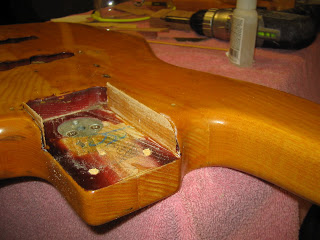
The sides required a little filing and sanding to get the neck into the pocket, but the fit was good, with still some side to side play, but at least better contact.
I then cleaned up and straightened the butt-end of the neck pocket with a Dremel MotoTool and a mini-router attachment - and glued in a fitted block of ash - which was clamped securely in place.
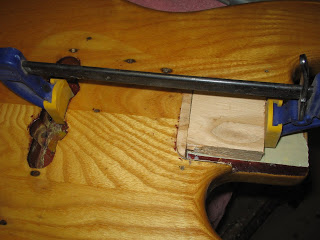
I then used the same router attachment - plus some small files and sandpaper - and lots of test fits - to get the best fit I could for the neck pocket to the neck. These pictures with the neck in place show that the fit while not perfect, is MUCH improved.

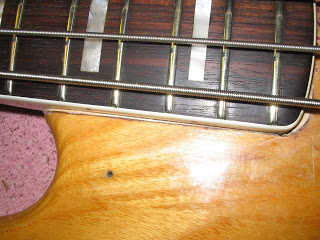
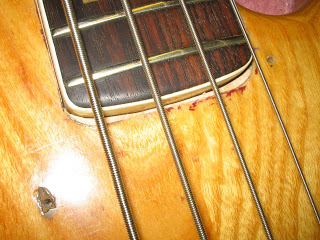
Next came the plugging of the two screw holes in the body and neck - and the re-drilling at a smaller bore - for which I once again bolted the neck in place with the single bolt, and then clamped the neck to align it properly, before redrilling with a drill press.
With the neck attachment tightened up all around - it was now time to refinish the body. I sprayed a piece of sanded ash with a nitro that was heavily tinted with a blend of medium brown, cherry red and a little walnut dye - until I achieved a color that looked like the finish that was in the neck pocket and pickup areas.
As with any transparent finish - I had to build up the color gradually - and I alternated between doing vertical passes on one coat and then horizontal passed on the next, to avoid getting subtle "stripes" in the finish.
This is a very difficult color to photograph - as it looks radically different depending on whether neon light, sunlight or a flash is illuminating it - the three pictures below are all of the same finish!
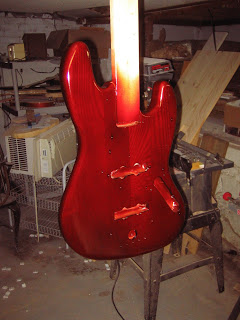

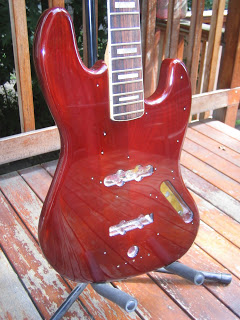
Eventually - I did set up the bass with some of my parts - a 70s bridge and tuners - to set up the truss rod properly and insure that the alignment of the strings was correct - before shipping the neck and body back to the owner for final assembly with the parts he had.

While this mod is a little tedious, in my opinion its a better option than converting a 3-bolt Fender to a 4-bolt - in terms of preserving the originality and vintage value of an instrument. I plan on doing the same mod to a 1976 project Fender Strat I have lurking in my basement as well.
- Neck Re-set
A neck re-set is the usually the biggest thing to happen in the life of an acoustic guitar. Over the years the string tension can cause the neck to change its angle to the top and make it impossible to get a lower action. The solution is to take the neck...
- 1968 Fender Jazz Bass: Sonic Blue Regret And Restoration
This project represents an unfortunately common scenario from the 1970s, where an instrument's owner decided that the "natural" look was preferable to the original factory custom color. Guess the attitude was that "wood was good" - during this...
- Sold!!: 66 Fender Jazz Bass, Lake Placid Blue
I have owned this bass for over a decade - I bought it from a guy in New Jersey, with the body completely stripped and clear coated but with an original Lake Placid Blue headstock. My plan all along was to restore it to its original finish - a couple...
- Sold!!: 1976 Fender Precision Bass, Olympic White
The mid-70s Fender Precision bass in Olympic White with a black pickguard was the weapon of choice for the one and only Dee Dee Ramone - I remember seeing the Ramone's countless times in New Jersey and New York - and Dee Dee had as many as three identical...
- Updated! 1966 Gibson Thunderbird: Gluing Back Together The Bits And Pieces!!
< This is one of the most ambitious rebuild projects I have undertaken yet - perhaps THE most ambitious - and it remains to be seen how it works out in the end. This is a project for a client - my friend David from New York, who owns the Guild Starfire...
Guitar
75 Jazz Bass: 3-bolt Fender Neck Pocket Tightening
In the early 70s, Fender switched from a traditional 4 screw or 4-bolt neck attachment to a 3-bolt attachment(actually 1 bolt and 2 screws) on the Stratocaster, the Jazz Bass and the Telecaster Bass. This new three-bolt attachment also incorporated a tilt adjustment, that could change the set angle of the neck in the body slightly.

While the tilt adjustment must have seemed like a good idea to someone, the net result was a much less secure neck attachment which could result in the neck having substantial side-to-side play. As a result, many instruments from this era were converted to 4-bolt attachments, through plugging and redrilling of the attachment points and removal of the tilt adjustment apparatus.
Over the past year, I have worked on two different 3-bolt Jazz basses - one a 1977 very clean condition, and one a 1975 that had been stripped of its finish and most of its parts.
The 1977 Jazz was the first time I realized what the true problem with the 3-bolt attachment was: while playing the bass and literally, wringing it out - I kept hearing a little "click" - that sounded like it was coming from the base of the neck. I eventually realized I was hearing the neck shifting left and right in the neck pocket - certainly not a good thing!
The shift was big enough that by pushing the headstock all the way to the "treble" side, I was able to have the G-string be at almost the edge of the fretboard - so that it rolled off during playing!! Definitely not good!!
I also noticed that the very end of the neck pocket - where the neck butted up against - was not the smooth curve that matched the butt of the neck, but rather just touched the neck at the very centerline.
Since the 1977 Jazz had a perfect original finish and I was basically just prepping it for shipment to a friend overseas, I decided to take a kind of short cut approach to take the play out of the 3-bolt mount.
I doweled the holes in the body - and also glued some splinters of maple into the neck screw holes, just to tighten then up. Then I attached the neck with the single "bolt" - and aligned the neck using string between the nut and the bridge - clamping the neck in position using a clamp with soft rubber clamping surfaces.
I redrilled the holes in the body with a smaller diameter drill bit (sorry - I forget what size) - small enough such that the screws would have to be threaded through the body AND into the neck.
Then, while the neck was still clamped in position - I installed the two neck screws and tightened them down.
The results was that the shifting of the neck disappeared - even if the neck to body fit wasn't very good - because the play around the neck screws was gone. A simple fix that at least stabilized the bass.
Then, a few months later, I received another 3-bolt Jazz Bass - this time a stripped 1975. The owner wanted to convert to a 4-bolt attachment, but I convinced him to let me try to stabilize the neck with a more ambitious approach - rather than drilling a number of holes through the body and into the neck - which in my opinion would greatly reduce their "vintage" value down the road.
What I proposed was to shim the sides of the neck pocket and then to fill in and re-rout the area of the pocket that butts up against the neck - as well as tighten up the two screw holes through the body.
This combined approach would then result in the neck making more contact with the body plus it would tighten up the whole connection so there would be no side to side play in the neck.
Since the body was going to be refinished anyway, any added would would be pretty well obscured by the finish.
The body had originally been Walnut - the reddish brown color that was available from around 1974 through 1979 or so. The original finish was visible in the neck pocket and the bottom of the pickup routings.
What I initially did was fit the neck onto the body - align it - and then measure the gaps on the long and short sides of the neck pocket. I then glued in in tapered shims cut from ash (which is what the body was made of.

The sides required a little filing and sanding to get the neck into the pocket, but the fit was good, with still some side to side play, but at least better contact.
I then cleaned up and straightened the butt-end of the neck pocket with a Dremel MotoTool and a mini-router attachment - and glued in a fitted block of ash - which was clamped securely in place.

I then used the same router attachment - plus some small files and sandpaper - and lots of test fits - to get the best fit I could for the neck pocket to the neck. These pictures with the neck in place show that the fit while not perfect, is MUCH improved.



Next came the plugging of the two screw holes in the body and neck - and the re-drilling at a smaller bore - for which I once again bolted the neck in place with the single bolt, and then clamped the neck to align it properly, before redrilling with a drill press.
With the neck attachment tightened up all around - it was now time to refinish the body. I sprayed a piece of sanded ash with a nitro that was heavily tinted with a blend of medium brown, cherry red and a little walnut dye - until I achieved a color that looked like the finish that was in the neck pocket and pickup areas.
As with any transparent finish - I had to build up the color gradually - and I alternated between doing vertical passes on one coat and then horizontal passed on the next, to avoid getting subtle "stripes" in the finish.
This is a very difficult color to photograph - as it looks radically different depending on whether neon light, sunlight or a flash is illuminating it - the three pictures below are all of the same finish!



Eventually - I did set up the bass with some of my parts - a 70s bridge and tuners - to set up the truss rod properly and insure that the alignment of the strings was correct - before shipping the neck and body back to the owner for final assembly with the parts he had.

While this mod is a little tedious, in my opinion its a better option than converting a 3-bolt Fender to a 4-bolt - in terms of preserving the originality and vintage value of an instrument. I plan on doing the same mod to a 1976 project Fender Strat I have lurking in my basement as well.
- Neck Re-set
A neck re-set is the usually the biggest thing to happen in the life of an acoustic guitar. Over the years the string tension can cause the neck to change its angle to the top and make it impossible to get a lower action. The solution is to take the neck...
- 1968 Fender Jazz Bass: Sonic Blue Regret And Restoration
This project represents an unfortunately common scenario from the 1970s, where an instrument's owner decided that the "natural" look was preferable to the original factory custom color. Guess the attitude was that "wood was good" - during this...
- Sold!!: 66 Fender Jazz Bass, Lake Placid Blue
I have owned this bass for over a decade - I bought it from a guy in New Jersey, with the body completely stripped and clear coated but with an original Lake Placid Blue headstock. My plan all along was to restore it to its original finish - a couple...
- Sold!!: 1976 Fender Precision Bass, Olympic White
The mid-70s Fender Precision bass in Olympic White with a black pickguard was the weapon of choice for the one and only Dee Dee Ramone - I remember seeing the Ramone's countless times in New Jersey and New York - and Dee Dee had as many as three identical...
- Updated! 1966 Gibson Thunderbird: Gluing Back Together The Bits And Pieces!!
< This is one of the most ambitious rebuild projects I have undertaken yet - perhaps THE most ambitious - and it remains to be seen how it works out in the end. This is a project for a client - my friend David from New York, who owns the Guild Starfire...
